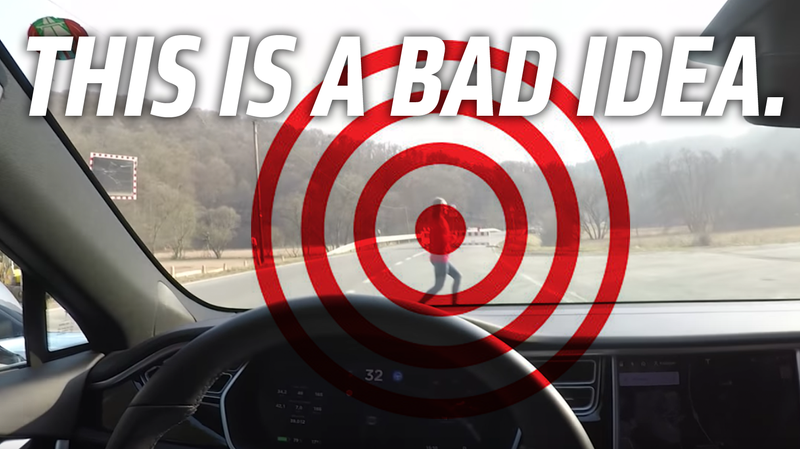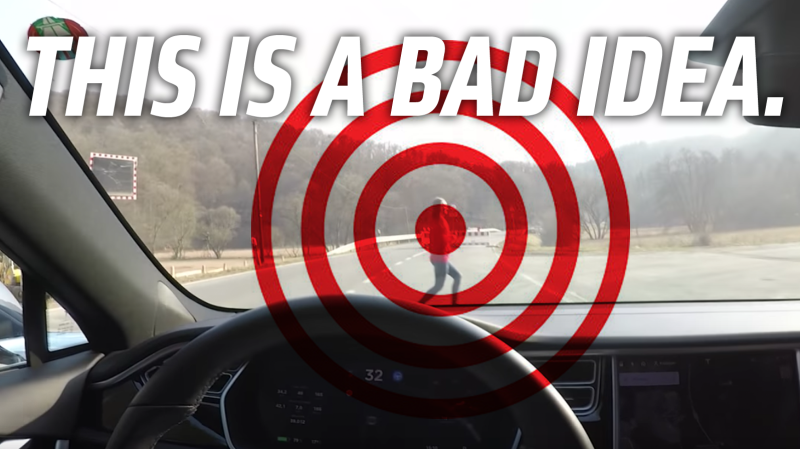
I’m by no means saying I’m the best husband at all, or that I have any reasonable advice to anyone regarding marriage. But, if I was forced to give one bit of marriage advice, I think I could feel confident in saying that, whenever possible, a happy marriage includes the idea of not driving your car right at your spouse, even if your car is a Tesla. At least one guy on the internet disagrees with me.
The guy with other ideas about how to treat your spouse goes by the YouTube user name KrisXstream, and I think he may have made an xstreamly terrible decision when he made this video testing his Tesla Model S’ Autopilot emergency braking system. Here, watch:
It’s worth pointing out that in his first test, he has autopilot on and gets up to a speed of around 30 kph, around 18.6 mph. That’s a pretty good clip when you’re talking about 4,000 pounds of Muskmachine hurling at a human woman.
In the first test, the car barely manages to stop before hitting the woman; at about 0:41 seconds into the video, you can see that the car is still going about 26 kph/16 mph when his wife is close and directly in front of the car.
A human would have slowed down and stopped way, way earlier than this. Yes, the car did soon stop, hard, but had she not scampered a bit out of the way or fallen down, I’m really not so sure she’d have avoided getting hit.

Advertisement
The next test is even scarier, because Autopilot doesn’t appear to have applied the brakes at all. You can see when Autopilot is active by the blue steering wheel icon in the instrument cluster; when he finally applies the brakes on his own, manually, at 20 kph/12.4 mph at 1:38 in the video, he’s alarmingly close to his wife, and you can see the autopilot icon has gone off in the dash, showing he had to de-activate it by manually braking:

Yikes.
Even better, after this attempt he tells his wife it didn’t work because she was “too slow.”
Advertisement

Well, maybe we give him the benefit of the doubt and say he felt the car’s reaction was too slow? I’m not entirely sure what he meant, but I am sure that it just doesn’t fucking matter, because the system failed and he had to emergency manually brake so as not to run over his wife.
That should be some kind of hint that maybe this isn’t such a hot idea.
Look, I can’t believe I have to even say this, but in general you shouldn’t drive with the intent of running over a loved one, even if you’re pretty damn sure the car won’t let you actually do it. I mean, I’ve messed about a bit with autonomous vehicles, trying to see if I could fool their sensors or whatever, but walking in front of a car going close to 20 mph with technology still in its toddler years is pretty much just asking for trouble.
Advertisement

The real car companies sure as hell don’t do things that way; they use dummies as their targets and real people inside the car, instead of the opposite way this guy tried.
Remember, people: These systems do not always work. Don’t test them out on people you love. Or even like.
Advertisement
We reached out to Tesla for comment; they responded by pointing me to a section of their owner’s manual that pretty clearly states that Autopilot was not intended for this sort of thing (emphasis mine):
Safety is a top priority at Tesla, and anyone attempting to purposefully strike another person or object with their Tesla is misusing the vehicle. It is paramount that our customers exercise safe behavior when using our vehicles, including remaining alert and ready to resume control at all times when using the car’s autonomous features, and braking to avoid a collision.
More information on Automatic Emergency Braking:
Model S and Model X are equipped with Automatic Emergency Braking (AEB), which is designed to engage the brakes at the last possible moment to avoid or mitigate a collision. AEB does not engage when an alternative collision avoidance strategy (e.g., driver steering) remains viable. Instead, when a collision threat is detected, forward collision warning alerts the driver to encourage them to take appropriate evasive action. AEB is a fallback safety feature that operates by design only at high levels of severity and should not be tested with live subjects.
- Warning: Automatic Emergency Braking is not designed to prevent a collision. At best, it can minimize the impact of a frontal collision by attempting to reduce your driving speed.
Advertisement
Also, back in 2016, Tesla provided effectively the same statement as above in response to a similar story.













